Book choices for today:
Sharks Gail Gibbons
Sharks Jonathan Sheikh-Miller
Sharks Doug Perrine
Sharks John Stevens
Look, a Shark! Tessa Kenan
Pumpkin Soup Helen Cooper
Apples and Pumpkins Anne Rockwell
From Seed to Pumpkin Wendy Pfeffer
Zoology: (first circle)
Need for lesson – Continent Globe (Montessori Materials), pictures of sharks, shark matching.
Zoology 11
What are some of the ways we know a fish is a fish and belongs to the fish group of vertebrates? They live in the water and breathe with gills. Fish lay eggs and swim with fins. We said that fish live in the water. In what kind of water do we find fish? If we look at our globe, the large bodies of water around the continents are Oceans and seas. Oceans and seas have salt water. Smaller bodies of water that are found on the continents are rivers, lakes, and ponds. These all have what is called freshwater. Fish can be found in freshwater and salt water.
What about sharks? Are they a kind of fish? Yes. They have fins, breathe with gills, and most lay eggs. There is something about shark bones though that is different. Sharks belong to a group of fish called Elasmobranchii. This group of fish have no bones, but have what is called cartilage. There are over 300 species or kinds of sharks! Some of them are; the great white, tiger shark, blue shark, hammerhead, and bull shark. Most have sharp teeth. Why do you think they have sharp teeth? Sharks are carnivores. We learned about carnivores, what does it mean to be a carnivore again? Sharks live in oceans and seas all around the earth, and some even live in freshwater.
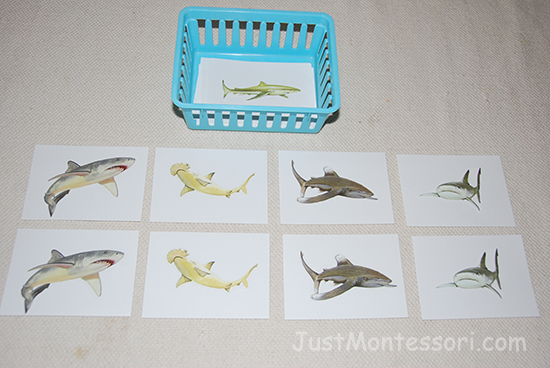
Art:
Shark Stencils – Children can trace inside of the shark stencils with a black pencil and then water color them.
Shark Sponge Painting – Have a large outline of one or two sharks made out of card stock paper, that has been cut out leaving a large stencil. Children can sponge paint inside of the shark body.
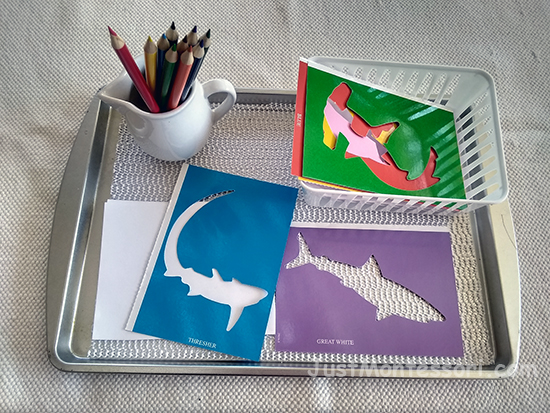
Botany: (second circle)
Need for lesson – Variety of seeds including winged seeds, white dandelion seed, and if available seeds with hooks or barbs, pumpkin sequence cards, and an avocado seed with toothpicks and container with water to sit it in.
Botany 13
We are going to look at our pumpkin story cards. All seeds have what inside of them? A baby plant waiting to grow. The roots begin to grow out of the seed and which way do they grow? Down. How do the stems grow? Upward. This happens after the seed is wet, and the seed coat comes off. It is called germination. In the pumpkin plant which way is the stem growing? Along the ground, it is a vine type of plant. So as the plant grows leaves appear. As it continues to grow we may see a flower on the plant. What did the flower do on the pumpkin plant? It shriveled up and then a pumpkin started to grow in its place. In our story of Jonathan and the pumpkin plant, he planted the seed that he found. How do plants grow if the seeds are not planted by a person?
Let’s look at some of these seeds. If they were not planted by a person, how might they grow into a plant? Well, some things that help seeds to travel and get planted are things like the wind and animals help too. These are dandelion seeds. We like these because we can blow them. If we blow them or the wind does, the seeds scatter in the air and land in another place. They may settle in the grass and if it rains they can grow to become more dandelion flowers. Animals help too. When squirrels gather nuts, like they are now to get ready for the winter, they bury some of the nuts in different places to dig up and eat in the winter. Sometimes squirrels do not go back and get all the nuts they buried so these will grow into new plants or trees. You can also help with seed travel. If you are walking in the woods and one of these seeds stick to your pants, and as you keep walking along it may rub against a rock or other plant and fall off. It can settle in that new place and grow into a new plant! Bees and birds also help in another way. We are going to talk more about them later.
This is an avocado seed. We are going to put it in water to see another way we can help seeds get started before we plant it in the ground. Let’s put it in water, using toothpicks to help hold it up (be sure to position the pit, flat side down, into the mouth of the container until the lower part is covered with water) and see what happens.
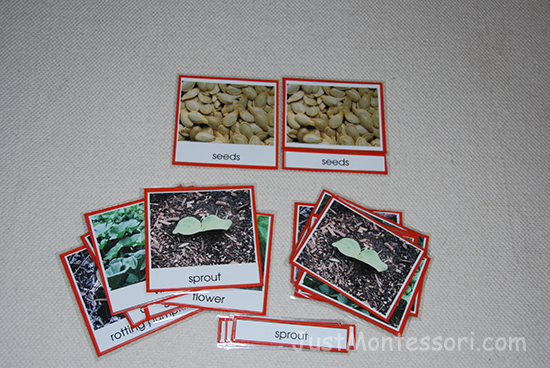
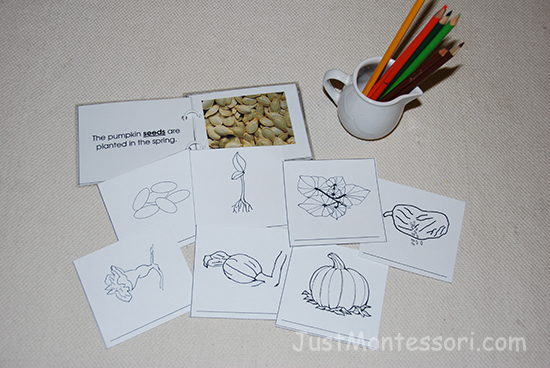
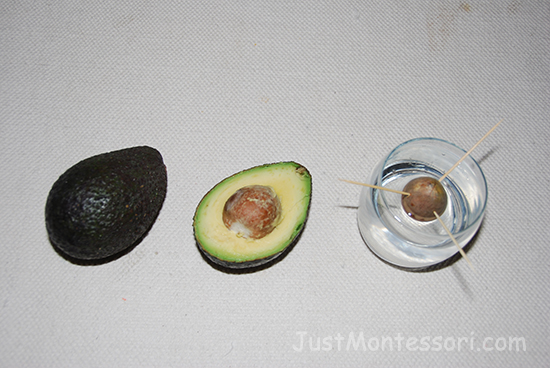
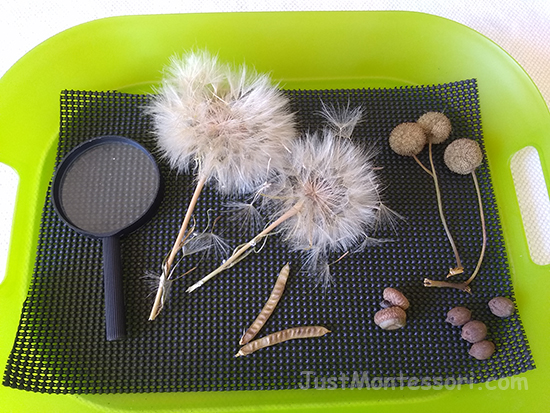
Additional Works:
Pumpkin Addition – I believe these are from kidssoup.com. For control of error, I wrote the answers on the back before I laminated them. Use with Short Bead Stair (Montessori Materials).
Seed Growing Coloring Page – This is an older copy of an avocado seed plant growing.
Pumpkin Game – This is from kidssoup.com. I changed it a little, adding a numeral 6 to the stem. This is a two player game. Each child gets a piece paper. They take turns rolling the die. They color the space on the pumpkin that matches their roll of the die. If they already have it colored, they miss that turn, and play goes to other child. The pumpkin that is colored first is the winner.

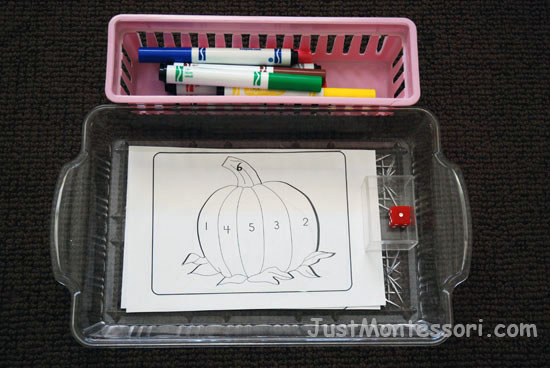
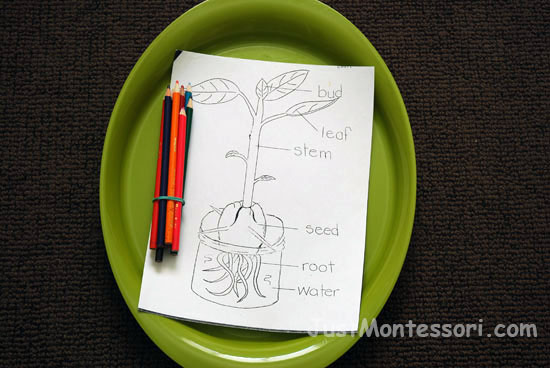
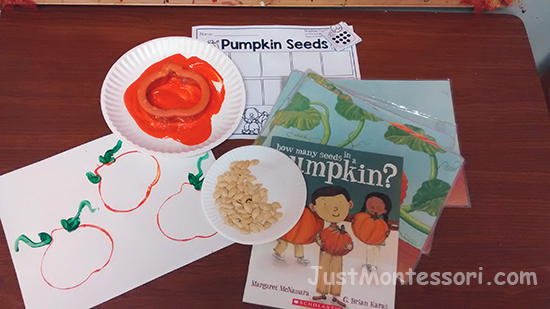
Practical Life:
Transfer Tongs – Children use tongs to transfer pom-poms into the pumpkin shape (cookie cutter) and then back into the container.
Tongs– These are little pumpkins from a craft store.
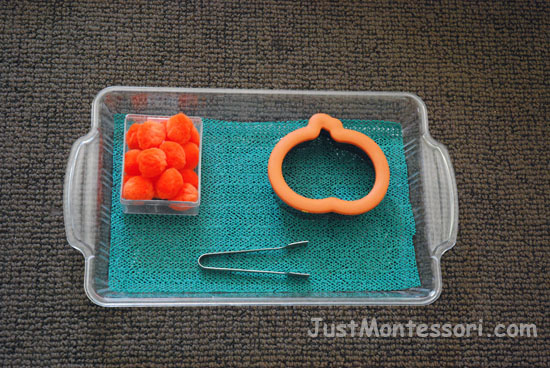
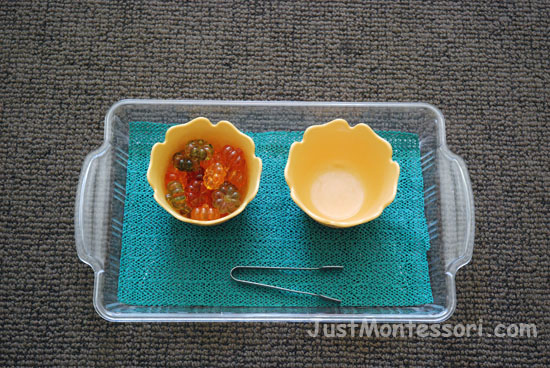
Songs/Poems:
Did You Ever See a Pumpkin? (tune – Ever See a Lassie)
Did you ever see a pumpkin, a pumpkin, a pumpkin
Did you ever see a pumpkin way down in the patch?
There are big ones, and little ones, there are bumpy ones, and flat ones
Did you ever see a pumpkin way down in the patch?
There are tall ones, and short ones, and yellow ones, and orange ones
Did you ever see a pumpkin way down in the patch?
The Pumpkins are Here (author unknown) Tune: “The Farmer in the Dell”
The pumpkins are here, the pumpkins are there,
The pumpkins, the pumpkins are everywhere.
The pumpkins are up, the pumpkins are down,
The pumpkins, the pumpkins are all around.
The pumpkins are in, the pumpkins are out,
The pumpkins, the pumpkins are all about.
The pumpkins are low, the pumpkins are high,
The pumpkins, the pumpkins all say good-bye!
Games:
Who Took the Pumpkin? (tune – Who Took the Cookie from the Cookie Jar?)
Who took the pumpkin from the pumpkin patch?
Lisa took the pumpkin from the pumpkin patch
Who me?
Yes you
Couldn’t be
Then who?
As you sing the song, go around the circle to each child that would like a turn. After the name of child is mentioned, they say the line themselves – “Who me?” and respond “Couldn’t be” after you sing “Yes you”.
Buy Weeks 6-10 PDF
-
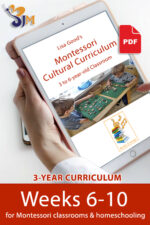 (C) Weeks 6-10$25.00
(C) Weeks 6-10$25.00


